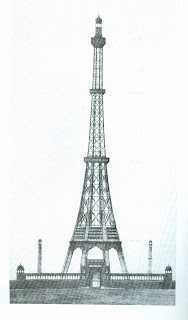It was the crowning achievement of his career. And it was the beginning of a feud.
At the 1889 inauguration of his famous Paris tower, Gustav Eiffel was feted as a French national hero.
 |
| Watkin: genial but mad |
But among the few who did not appreciate his iron skyscraper was a patriotic Englishman named Edward Watkin.
Watkin resented the Eiffel Tower for one simple reason: itstood more than five times higher than Britain’s national monument, Nelson’sColumn.
As far as Watkin was concerned, Gustav Eiffel had throwndown the gauntlet. He made a private vow to construct a British tower thatwould be taller, bigger and more spectacular than anything the French couldbuild.
 |
| Declined Watkin's kind offer |
Watkin had made his fortune in railways, creating networksin England, India and the Belgian Congo.
Immensely energetic and deeplyambitious, he also happened to be a proud nationalist.
Ever-the-entrepreneur, Watkin also had his eye on increasinghis fortune. He reasoned that if the new British mega-tower was built inWembley Park - a large area of unused land to the north-west of London - thenhis own Metropolitan Railway could transport the thousands of annual visitorsto the site.
 |
| Some crazy designs |
Watkin launched his competition to build the British tower within months of the inauguration of Eiffel's rival tower.
‘Anything Paris can do, London can do better!’ was hisboast.
By the end of 1889, architects from across the world wereworking on designs for a tower that would be taller and more spectacular thanEiffel’s.
Watkin’s idea fired the public imagination and his MetropolitanTower Construction Company became a byword for national pride. The Companyoffered a prize of 500 guineas for the best designed tower.
With more than a hint of mischief, Watkin even dared toapproach Gustav Eiffel and ask if he’d like to submit an entry. Eiffel politelydeclined.
‘If I,’ he said, ‘after erecting my tower on French soil,were to erect one in England, they would not think me so good a Frenchman as Ihope I am.’
 |
| The winning design |
Soon the designs began to arrive on Watkin’s desk - fromItaly, Sweden and Turkey, as well as many other countries.
Watkin quickly realised that most of the designs werefrankly preposterous. One, named Ye Vegetarian Tower, was submitted by theLondon Vegetarian Society. It came complete with hanging vegetable gardens.
Another, the so-called Tower of Babel, was so vast in scalethat it had a road and railway leading to the top.
Perhaps the most extraordinary design - of a tower fartaller than Eiffel’s - was to be built entirely of glass.
As Watkin flicked through the numerous entries, he realisedthere was only one design that was actually practical. It was made of openmetal lattice work and rose to a point at the top. Standing upon four legs (theoriginal design had six) it was in every respect an exact copy of the EiffelTower. The only difference was that it was 87 feet taller.
 |
| Watkin's Tower: no need to go to Paris |
Building work began immediately. By 1891, the giganticfoundation holes in Wembley Park had been plugged with concrete and work beganon the 3,000-ton tower itself.
It had soon reached a height of 62 feet and curiousLondoners began to flock to see the fledgling Watkin’s Tower.
Watkin claimed it would be finished by 1894. But when thesurrounding park was opened to the public, the tower was still only 155 feethigh.
 |
| Better go to Paris after all. |
Some 100,000 people came to see the stump; most wereextremely disappointed to see a partial replica of Eiffel’s Frenchtour-de-force. Only 18,500 bothered to buy a ticket to ascend to the first (andonly) level.
At the end of 1894. Watkin’s workmen downed their tools. TheMetropolitan Tower Construction Company had run out of money and the generalpublic no longer had any enthusiasm. The tower was abandoned.
For the next 13 years, Watkin’s folly remained as anembarrassment on the London skyline - a rusting and derelict eyesore.
It was finally blown up in 1907, a sorry end to a chapter ofAnglo-French rivalry.
Watkin’s only consolation was to have died six yearsearlier.
Wolfram: The Boy Who Went to War available here for just £5.30
And for my American readers, it is now published under the title: The Boy Who Went to War: The Story of a Reluctant German Soldier in WWII available here










